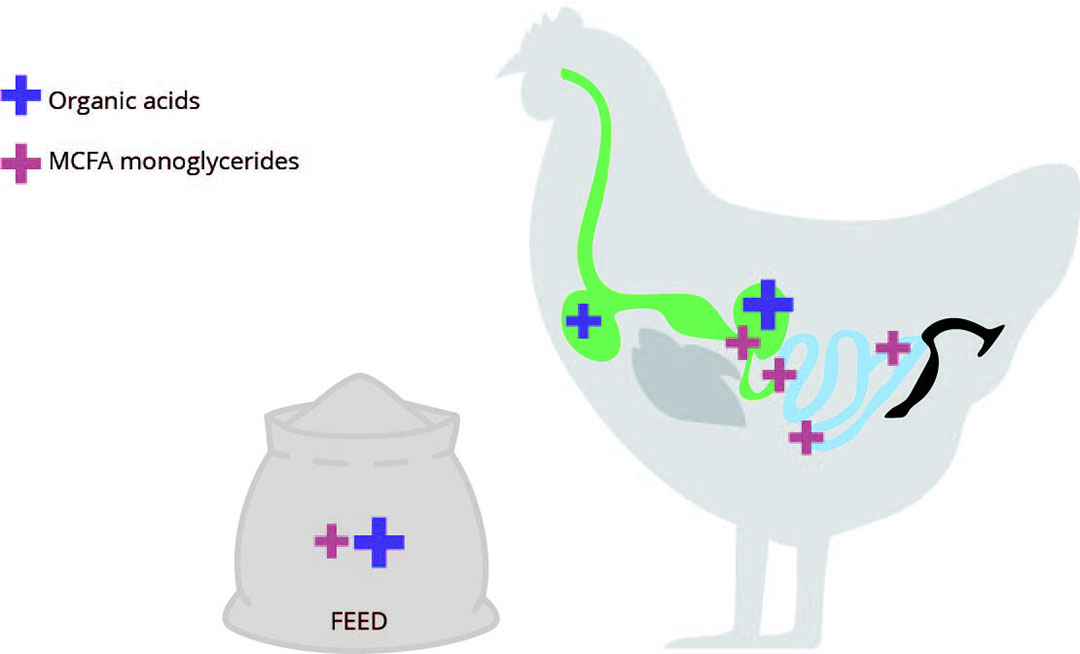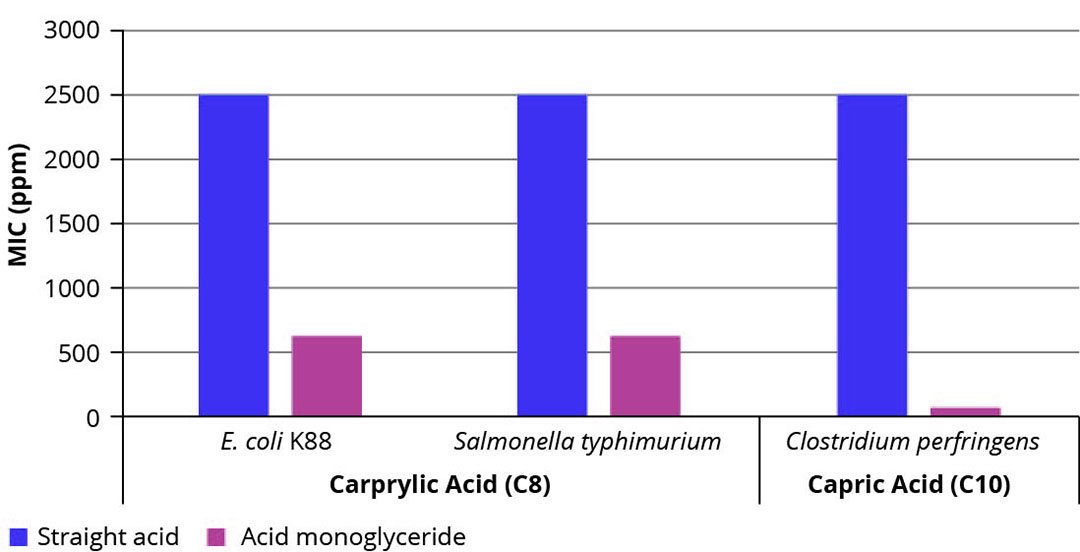Aid gut health with monoglycerides and organic acids

Combining monoglycerides of butyric and medium chain fatty acids is a very effective strategy to control pathogen growth and support gut health in broilers.
Part of the Gut Health 2022 Special
The reduction in usage of antimicrobial growth promoters and pressure to reduce therapeutic antimicrobial use has seen increased levels of small intestinal inflammation in broilers. Subsequently, wet litter, foot pad lesions and breast myopathies have been observed. This is especially true in rapidly growing broiler strains with high levels of feed intake which can cause an oversupply of nutrients in the intestinal lumen, metabolic pressure, and oxidative stress. This coupled with subclinical coccidiosis and dietary stress creates the ideal conditions for bacterial enteritis.
Addressing these welfare issues is crucial, not only to improve bird welfare, but also for social acceptability of the broiler industry.
Intestinal inflammation
The microbiota consists of both commensals as well as pathogenic bacteria, such as E. coli but problems only really occur when the normal ileal microbiota is overgrown by caecal pathogenic bacteria, such as Clostridium, magnified by anti-peristaltic movements. This translocation of the microbiota in these high-performing birds causes extra local inflammation and oxidative stress in the mucosa. Due to damage to the intestinal cells, morphological changes occur and consequently, there is poor absorption of nutrients, which further exasperates the oversupply of nutrients in the lumen and the vicious circle starts again.
Local inflammation becomes systemic
Once pathogenic bacteria slip through the impaired gut barrier – so-called bacterial translocation – they are transported throughout the body via the bloodstream, causing inflammation in other organs and other locations, such as the joints. A relevant example of this is the spondylitis outbreaks in broilers due to Enterococcus cecorum.
Organic acids support a healthy gut
Firstly, since pepsin has a pH optimum of 2, formic acid ensures this pH optimum in the proventriculus-gizzard for optimal protein digestion while simultaneously being an important barrier for acid-sensitive bacteria.
Secondly, butyric acid derivatives play a role in gut and overall health in the prevention of local and systemic inflammation, and in providing the building blocks for a strong systemic immunity, reducing oxidative stress. Butyric acid derivatives help maintain the integrity by strengthening the barrier of the intestine. Healthy tight junctions between enterocytes are an important gut barrier for bacteria. Butyric acid can affect innate as well as adaptive immune cells.
Thirdly, medium chain fatty acids and certainly medium chain monoglycerides have strong effects on microbial modulation and pathogen inhibition.
Therefore, there is a need for an integrated approach with a focus on adaptive response mechanisms to reduce inflammation and oxidative stress on the one hand and control bacteria growth on the other hand.
Figure 1 – Combinations of organic acids and monoglycerides have activity all along the GIT.

Medium chain monoglycerides
Monoglycerides are glycerol monoesters of organic acids, meaning that a glycerol molecule is covalently bound to an organic acid on position 1. As a result, no dissociation occurs, and they are not dependent on pH for their activity, meaning the monoglycerides can elicit their activity further into the GI tract (Figure 1). This chemical structure also means that monoglycerides interact directly with the cell membrane of bacterial cells which is different to the mode of action of straight organic acids.
Medium chain monoglycerides are more effective microbial modulators compared to straight medium chain fatty acids as evidenced by differences in the minimum inhibitory concentration (MIC) against different bacteria. These findings have been confirmed in research conducted in Eastman’s microbiology lab (Figure 2).
Figure 2 – Effect of monoglycerides of caprylic acid and capric acid vs. straight caprylic acid (C8) and straight capric acid (C10) on MIC values for E.coli, S. typhimurium and C. Perfringens.

Effective strategy combining different monoglycerides
Combining monoglycerides of butyric and medium chain fatty acids is a very effective strategy to control pathogen growth and support gut health. Further combining with a formic acid-based blend, also ensures a good gastric barrier against incoming bacteria and a good protein digestion.
The synergies between these different molecules have been harnessed in Eastman’s Acitra, Entero-Nova and Protaq product portfolios. Monoglycerides are non-corrosive and have less odour, which makes them very easy to handle. They are available both in solid and liquid forms, through feed and water applications.
While the use of monoglycerides in general has been well established in recent years, Eastman is developing tailor-made solutions for specific health challenges in poultry and swine. This approach is supported by a sophisticated and flexible production facility in Ávila Spain.
References are available on request.
Join 13,000+ subscribers
Subscribe to our newsletter to stay updated about all the need-to-know content in the dairy sector, two times a week.






